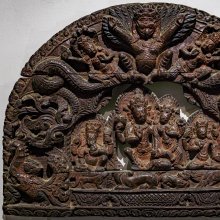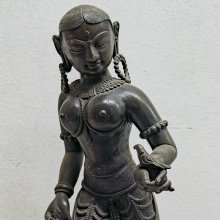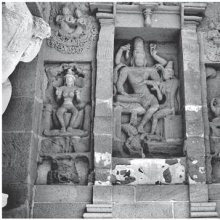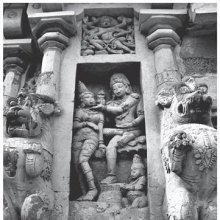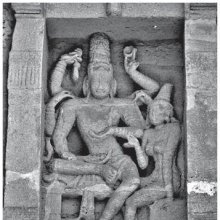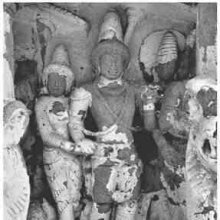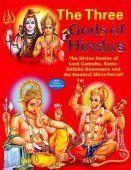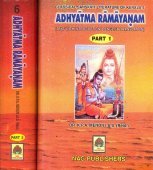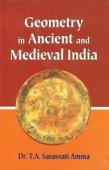Parvati, Pārvatī: 34 definitions
Introduction:
Parvati means something in Hinduism, Sanskrit, Jainism, Prakrit, the history of ancient India, Marathi, Hindi, biology, Tamil. If you want to know the exact meaning, history, etymology or English translation of this term then check out the descriptions on this page. Add your comment or reference to a book if you want to contribute to this summary article.
Images (photo gallery)
(+70 more images available)
In Hinduism
Natyashastra (theatrics and dramaturgy)
Source: archive.org: The mirror of gesture (abhinaya-darpana)One of the Deva-vibhāvana (hands that indicate the forms which accord with the character and actions of Brahmā and other Devas).—Pārvatī: Ardha-candra with both hands, the left upward, the right downward, making Abhaya and Varada (Fear not, and Charity).

Natyashastra (नाट्यशास्त्र, nāṭyaśāstra) refers to both the ancient Indian tradition (shastra) of performing arts, (natya—theatrics, drama, dance, music), as well as the name of a Sanskrit work dealing with these subjects. It also teaches the rules for composing Dramatic plays (nataka), construction and performance of Theater, and Poetic works (kavya).
Purana and Itihasa (epic history)
Source: archive.org: Puranic EncyclopediaPārvatī (पार्वती).—Wife of Śiva.
Pārvatī is known under different names and worshipped in different forms. Amarakośa (Sanskrit lexicon) gives the following synonyms for Pārvatī: (See full article at Story of Pārvatī from the Puranic encyclopaedia by Vettam Mani)
Source: archive.org: Shiva Purana - English TranslationPārvatī (पार्वती) is the wife of Śiva, as mentioned in the Śivapurāṇa-māhātmya chapter 5.—In the Pauranic Mythology, Pārvatī is the daughter of Himālaya and the wife of Śiva. In the cult of Śakti and Tantras, she has been identified with Prakṛti itself. Almost all the Purāṇas speak of her as Prakṛti and her three Guṇas: sattva, rajas and tamas are the three Gods: Brahmā, Viṣṇu and Śiva.
Accordingly, as Cañculā spoke in praise of Umā Pārvatī: “O mother of Skanda, daughter of mountain, Thou art always served by men. O beloved of Śiva, the bestower of all pleasures, having the form of Supreme Brahman, Thou art worthy of being served by Viṣṇu, Brahmā and others. Thou art both endowed with and devoid of attributes. Thou art the subtle primordial Prakṛti, with Existence, Knowledge and Bliss for thy forms. Thou createst, maintainest and annihilatest. Thou hast the three Guṇas. Thou art the refuge of the three types of divine beings. Thou sustainest Brahmā, Viṣṇu and Maheśa”.
Pārvatī was born of Menā after the latter was cursed by Sanatkumāra, according to the Śivapurāṇa 2.3.2.—Accordingly, as Sanatkumāra said to the three daughters of Svadhā (i.e., Menā, Dhanyā and Kalāvatī):—“[...] O ye three daughters of forefathers (i.e., Menā), listen with pleasure to my words that will dispel your sorrow and bestow happiness on you. May the eldest among you become the wife of Himavat the mountain that is a part of Viṣṇu. Pārvatī shall be her daughter. [...] The Yoginī Menā shall attain the great region Kailāsa along with her body and in the company of her husband due to the boon of Pārvatī. [...] Ye the daughters of forefathers (i.e., Menā) shall shine in heaven. By the vision of Viṣṇu your evil actions have been quelled. [...] Menā’s daughter, goddess Pārvatī, the mother of the universe shall become Śiva’s beloved after performing severe penance”.
Source: Academia.edu: Tejas Transactions in the Itihāsa-PurāṇaPārvatī is the wife of Śiva, according to the Bhaviṣya Purāṇa (3.14.22ff.), when the gods approached Śiva requesting him to marry Pārvatī in order to beget a son equal to the task of slaying Tāraka, Śiva protested his inability to comply on account of his chastity vow, and on account of the Goddess being the universal mother. For the sake of the gods, however, he was willing to devolve his vīrya to Agni, which would do the needful on his behalf.
Source: Cologne Digital Sanskrit Dictionaries: The Purana Index1a) Pārvatī (पार्वती).—Umā, wife of Śiva, attained half body of Śiva by virtue of the 108 names of the Devī;1 (Ambā), the family deity of the Vidarbhas; present when Śiva gave his missile to Arjuna;2 conceived true love even as a girl;3 went with Śiva to have a look at the Mohinī form of Viṣṇu;4 once when she was sitting unclad on the lap of Śiva there came some sages to see the Lord; ashamed she got herself clothed; to please her Śiva said that any male who entered that place thereafter would become a female;5 presented Pṛthu with a sword Śatacandra;6 prayed to by Rukminī to get Kṛṣṇa for her husband; to her shrine Rukminī went by foot and offered worship for the hand of Kṛṣṇa;7 Vṛka's aim to take her after killing Śiva;8 prevented the enraged Śiva from killing Bhṛgu;9 saw Mārkaṇḍeya engaged in tapas.10 A Śakti;11 felt for Vināyaka losing his teeth through Paraśurāma and appealed to Śiva who remembered Kṛṣṇa. The latter came with Rādhā and consoled her by addressing on Gaṇeśa's greatness.
- 1) Matsya-purāṇa 12. 9; 13. 51 and 60; 85. 6; 183. 14; 187. 44; Vāyu-purāṇa 54. 20; 108. 51; 112. 35; Viṣṇu-purāṇa V. 32. 11-15.
- 2) Bhāgavata-purāṇa I. 15. 12; X. 52. 42.
- 3) Ib. X. 60. 47.
- 4) Ib. VIII. 12. 2 and 25.
- 5) Ib. IX. 1. 29-32.
- 6) Ib. IV. 15. 17; VI. 17. 11-12.
- 7) Ib. X. 53. 25, 39-40 and 44-49.
- 8) Ib. X. 88. 23.
- 9) Ib. X. 89. 7.
- 10) Ib. XII. 10. 3 and 35.
- 11) Brahmāṇḍa-purāṇa II. 25. 23; III. 41. 38, 50; 42. 7, 17; 44. 28; IV. 6. 8, 30, 38; 10. 41, 42.
1b) A name of the R. Nandā.*
- * Vāyu-purāṇa 49. 92.
1c) (alias vijayā); wife of Sahādeva and mother of Suhotra.*
- * Bhāgavata-purāṇa IX. 22. 31.
Pārvatī (पार्वती) is a name mentioned in the Mahābhārata (cf. IX.44.47) and represents one of the many proper names used for people and places. Note: The Mahābhārata (mentioning Pārvatī) is a Sanskrit epic poem consisting of 100,000 ślokas (metrical verses) and is over 2000 years old.

The Purana (पुराण, purāṇas) refers to Sanskrit literature preserving ancient India’s vast cultural history, including historical legends, religious ceremonies, various arts and sciences. The eighteen mahapuranas total over 400,000 shlokas (metrical couplets) and date to at least several centuries BCE.
Shilpashastra (iconography)
Source: Red Zambala: Hindu Icons and Symbols | DeviPārvatī (पार्वती) is a gentle benevolent goddess, daughter of the axial mountain — the Himalaya, from which the earth energy radiates into space. The mountain (parvata) or Himavat (“the snow-capped-one”) is a symbol of ether — Ākāśa.
The peaks of the mountains are regarded as the places from which the earth energy flows into the ether. No dwellings are built on top of mountains and hills and only places of worship may be built there.
The mother of Pārvatī is Menakā, who represents intellect (buddhi). Born of Ether and Intellect, Pārvatī is the omnipresent conscious substance of the universe. Pārvatī is also the matron of all the elemental spirits — the bhūtas and gaṇas (‘categories’) that wander about the earth.
Source: Shodhganga: The significance of the mūla-beras (śilpa)Pārvatī is the name of a deity depicted in the Aruṇācaleśvar or Arunachaleswara Temple in Thiruvannamalai (Tiruvaṇṇāmalai) which is one of the Pañcasabhā or “five halls where Śiva is said to have danced”.—Pārvatī is found to stand to the left of Śiva. She is found with two hands where the right hand holds kaṭaka-hasta and the left hand is in dolā.

Shilpashastra (शिल्पशास्त्र, śilpaśāstra) represents the ancient Indian science (shastra) of creative arts (shilpa) such as sculpture, iconography and painting. Closely related to Vastushastra (architecture), they often share the same literature.
Shaktism (Shakta philosophy)
Source: Wisdom Library: ŚāktismPārvatī (पार्वती, “Daughter of the Mountain”).—One of the names of the Goddess, Devī, who is regarded as the female principle of the divine; the embodiement of the energies of the Gods.
Source: Google Books: ManthanabhairavatantramPārvatī (पार्वती) refers to the “Great Goddess” (Mahādevī), according to the Kulakaulinīmata verse 20.505cd-508ab.—Accordingly, “Akula is said to be Kaula. It is Maheśvara, the womb in the womb of the most excellent body. O mistress of the gods, he is present everywhere. The abode of Kula is in Kaula, that is, in one's own divine Kula, one’s own nature and form devoid of the body. One should enter into the Self by the Self. The Great Goddess engaged in intercourse within the great Śiva is Pārvatī. By means of the bliss (of this union one) attains the supreme principle and by (that) principle, the supreme (state)”.

Shakta (शाक्त, śākta) or Shaktism (śāktism) represents a tradition of Hinduism where the Goddess (Devi) is revered and worshipped. Shakta literature includes a range of scriptures, including various Agamas and Tantras, although its roots may be traced back to the Vedas.
Kavya (poetry)
Source: Wisdom Library: KathāsaritsāgaraPārvatī (पार्वती) is the beloved of Maheśvara, who is mentioned as the “chief of things animate and inanimate”. Their dwelling place is the mountain-peak Kailāsa, located within Himavat, according to the Kathāsaritsāgara, chapter 1. Accordingly, “There (Kailāsa) dwells Maheśvara the beloved of Pārvatī, the chief of things animate and inanimate, attended upon by Gaṇas, Vidyādharas and Siddhas. In the upstanding yellow tufts of his matted hair the new moon enjoys the delight of touching the eastern mountain yellow in the evening twilight.”
The Kathāsaritsāgara (‘ocean of streams of story’), mentioning Pārvatī, is a famous Sanskrit epic story revolving around prince Naravāhanadatta and his quest to become the emperor of the vidyādharas (celestial beings). The work is said to have been an adaptation of Guṇāḍhya’s Bṛhatkathā consisting of 100,000 verses, which in turn is part of a larger work containing 700,000 verses.

Kavya (काव्य, kavya) refers to Sanskrit poetry, a popular ancient Indian tradition of literature. There have been many Sanskrit poets over the ages, hailing from ancient India and beyond. This topic includes mahakavya, or ‘epic poetry’ and natya, or ‘dramatic poetry’.
Vastushastra (architecture)
Source: Shodhganga: Temples of Salem region Up to 1336 ADPārvatī (पार्वती).—Sculptures of Pārvatī, called by different names locally, are available in good numbers. These are all cult objects enshrined in the Amman shrines of the different Śiva temples of the region (southern India). They are all sculptures, carved in the round, with or with out a prabhāvali. They are carved either in sthānaka or in the āsīna postures. The standing sculptures are all in samabhaṅga or tribhaṅga postures. They are always four handed holding in their upper hands pāśa and aṅkuśa and the lower hands are disposed in abhaya and varada mudras. The decorations are all conventional and traditional.

Vastushastra (वास्तुशास्त्र, vāstuśāstra) refers to the ancient Indian science (shastra) of architecture (vastu), dealing with topics such architecture, sculpture, town-building, fort building and various other constructions. Vastu also deals with the philosophy of the architectural relation with the cosmic universe.
Shaivism (Shaiva philosophy)
Source: Shodhganga: Iconographical representations of ŚivaPārvatī (पार्वती) or Pārvatyāgama refers to one of upāgamas (supplementary scriptures) of the Ajitāgama which is one of the twenty-eight Siddhāntāgama: a classification of the Śaiva division of Śaivāgamas. The Śaivāgamas represent the wisdom that has come down from lord Śiva, received by Pārvatī and accepted by Viṣṇu. The purpose of revealing upāgamas (e.g., Pārvatī Āgama) is to explain more elaborately than that of mūlāgamas (e.g., Ajita-āgama) and to include any new idea if not dealt in mūlāgamas.
Source: Shodhganga: The significance of the mūla-beras (shaivism)Pārvatī (पार्वती) refers to the wife of Śiva. There are many avatāra images of Śakti (or Pārvatī), namely Śrī Mīnākṣī, Kāmākṣi, Durgā, Mahiṣāsuramardinī, Bhairavī, Kāntimati Ampāl, Candikeśvarī and many more. Each manifestation of Pārvatī has a special attribute of its own. Each avatāra was taken for a special purpose but ultimately it was for the benefit and salvation of the devotees.
Source: Shodhganga: The saurapurana - a critical study (shaivism)Pārvatī (पार्वती) is the consort of Śiva, according to the 10th century Saurapurāṇa: one of the various Upapurāṇas depicting Śaivism.—Pārvatī is Śiva’s imperishable Energy—avvayā śakti. [...] In a passage of the Saurapurāṇa Pārvatī herself expresses before Himālaya that she is the will-power , power of knowledge, power of motivation and power of vital-air of Śiva and the latter is Śaktimān. She is Māyā and Śiva is Māyin. She is called Nityā, Ādimadhyāntarahitā, Nityānandā etc. She is inseparably connected with Śiva just as the power of burning is connected with fire; with her Śiva creates, protects and destroys the universe.
The Saurapurāṇa emphasises on the glorification of the worship of Pārvatī and a vrata named Ulkānavamī-vrata is enjoined to be observed in her honour and it is said that great merits await the worshippers of Pārvatī.

Shaiva (शैव, śaiva) or Shaivism (śaivism) represents a tradition of Hinduism worshiping Shiva as the supreme being. Closely related to Shaktism, Shaiva literature includes a range of scriptures, including Tantras, while the root of this tradition may be traced back to the ancient Vedas.
Vaishnavism (Vaishava dharma)
Source: Pure Bhakti: Brhad BhagavatamrtamPārvatī (पार्वती) refers to:—Lord Śiva’s consort; daughter of Parvata (the Himālayas); another name for the goddess Kāmākhyā-devī; also known as Durga, Gauri, Kali. (cf. Glossary page from Śrī Bṛhad-bhāgavatāmṛta).

Vaishnava (वैष्णव, vaiṣṇava) or vaishnavism (vaiṣṇavism) represents a tradition of Hinduism worshipping Vishnu as the supreme Lord. Similar to the Shaktism and Shaivism traditions, Vaishnavism also developed as an individual movement, famous for its exposition of the dashavatara (‘ten avatars of Vishnu’).
Ayurveda (science of life)
Nighantu (Synonyms and Characteristics of Drugs and technical terms)
Source: WorldCat: Rāj nighaṇṭu1) Pārvatī (पार्वती) is another name for Kṣudrapāṣāṇabheda, an unidentified medicinal plant, according to verse 5.45-46 of the 13th-century Raj Nighantu or Rājanighaṇṭu. The fifth chapter (parpaṭādi-varga) of this book enumerates sixty varieties of smaller plants (kṣudra-kṣupa). Together with the names Pārvatī and Kṣudrapāṣāṇabheda, there are a total of ten Sanskrit synonyms identified for this plant.
2) Pārvatī (पार्वती) is another name for Saiṃhalī, a medicinal plant identified with Piper retrofractum Vahl. or “Balinese long pepper” from the Piperaceae or ‘pepper’ family of flowering plants, according to verse 6.16-18. The sixth chapter (pippalyādi-varga) of this book enumerates ninety-five varieties of plants obtained from the market (paṇyauṣadhi). Together with the names Pārvatī and Saiṃhalī, there are a total of sixteen Sanskrit synonyms identified for this plant.

Āyurveda (आयुर्वेद, ayurveda) is a branch of Indian science dealing with medicine, herbalism, taxology, anatomy, surgery, alchemy and related topics. Traditional practice of Āyurveda in ancient India dates back to at least the first millenium BC. Literature is commonly written in Sanskrit using various poetic metres.
Yoga (school of philosophy)
Source: ORA: Amanaska (king of all yogas): A Critical Edition and Annotated Translation by Jason BirchPārvatī (पार्वती) refers to the “earth element”, according to verse 6.21.14 of the Mokṣopāya.—Accordingly, as Bhuśuṇḍa said to Vasiṣṭha: “[...] When the suns blaze and the mountains have become rubble, then, having performed concentration on the water element, I remain with my mind steady. When the lords of the mountains have been pulverized and the winds of the dissolution blow, then, having performed concentration on the earth element (pārvatī), I remain unmoving in the ether. [...]”.

Yoga is originally considered a branch of Hindu philosophy (astika), but both ancient and modern Yoga combine the physical, mental and spiritual. Yoga teaches various physical techniques also known as āsanas (postures), used for various purposes (eg., meditation, contemplation, relaxation).
General definition (in Hinduism)
Source: Apam Napat: Indian MythologyParvati is the wife of Shiva. She is also known as Ambika or Shakti. In her aspect as Parvati she is a benevolent goddess, granting the boons of her worshippers. However, in her aspect as Kali, she is a fierce goddess, the destroyer of her foes and has a terrible visage.
The Devi Bhagavata is the collection of stories involving her, and details many of her incarnations. She is also said to possess overlordship of the Navagrahas (nine planets).
Source: WikiPedia: HinduismParvati (पार्वती, Pārvatī) is another form of Shakti, the wife of Shiva and the gentle aspect of Maha Devi or Durga, the Great Goddess. Parvati is considered to be a complete incarnation of Adi Parashakti or Goddess Durga, with all other Goddesses being her incarnations or manifestations. Parvati, when depicted alongside Shiva, generally appears with two arms, but when alone, she is depicted having four, eight or ten arms, and is astride on a tiger or lion. Parvata is one of the Sanskrit words for "mountain"; "Parvati" translates to "She of the mountains" and refers to Parvati being born the daughter of Himavan, lord of the mountains and the personification of the Himalayas.
In Jainism
General definition (in Jainism)
Source: archive.org: TrisastisalakapurusacaritraPārvatī (पार्वती) or Pārvatīvidyā refers to one of the sixteen Vidyās from which are derived the respective classes of Vidyādharas (in this case, Pārvata), according to chapter 1.3 [ādīśvara-caritra] of Hemacandra’s 11th century Triṣaṣṭiśalākāpuruṣacaritra: an ancient Sanskrit epic poem narrating the history and legends of sixty-three illustrious persons in Jainism.
Accordingly,
“[...] After making [the two rows of Vidyādhara-cities], many villages and suburbs, they established communities [viz., the Pārvatas] according to the suitability of place. [...] Dharaṇendra instructed them about the law as follows: ‘If any insolent persons show disrespect or do injury to the Jinas, or the Jinas’ shrines, or to those who will attain mokṣa in this birth, or to any ascetics engaged in pratimā, the Vidyās [viz., Pārvatīs] will abandon them at once, just as wealth abandons lazy people. Whoever kills a man with his wife, or enjoys women against their will, the Vidyās will abandon him at once’.”

Jainism is an Indian religion of Dharma whose doctrine revolves around harmlessness (ahimsa) towards every living being. The two major branches (Digambara and Svetambara) of Jainism stimulate self-control (or, shramana, ‘self-reliance’) and spiritual development through a path of peace for the soul to progess to the ultimate goal.
India history and geography
Source: Shodhganga: A translation of Jhaverchand Meghanis non translated folk talesParvati refers to “The daughter of parvat (mountain). Parvati was the daughter of the king of mountain Himalaya and Mena. Parvati the wife of Lord Shiva is known as Sati, Gauri, Umiya, Uma, Katyayani etc. Ganesh and Kartikey are his sons”.—It is defined in the glossary attached to the study dealing with Gujarat Folk tales composed by Gujarati poet Jhaverchand Meghani (1896-1947)

The history of India traces the identification of countries, villages, towns and other regions of India, as well as mythology, zoology, royal dynasties, rulers, tribes, local festivities and traditions and regional languages. Ancient India enjoyed religious freedom and encourages the path of Dharma, a concept common to Buddhism, Hinduism, and Jainism.
Biology (plants and animals)
Source: Wisdom Library: Local Names of Plants and DrugsParvati [पार्वती] in the Sanskrit language is the name of a plant identified with Woodfordia fruticosa (L.) Kurz from the Lythraceae (Crape Myrtle) family having the following synonyms: Woodfordia floribunda. For the possible medicinal usage of parvati, you can check this page for potential sources and references, although be aware that any some or none of the side-effects may not be mentioned here, wether they be harmful or beneficial to health.
Parvati [पार्वती] in the Sanskrit language is the name of a plant identified with Boswellia serrata Roxb. ex Colebr. from the Burseraceae (Torchwood) family having the following synonyms: Boswellia glabra, Boswellia thurifera, Bursera thurifera.
Source: Google Books: CRC World Dictionary (Regional names)1) Parvati in India is the name of a plant defined with Anacardium occidentale in various botanical sources. This page contains potential references in Ayurveda, modern medicine, and other folk traditions or local practices It has the synonym Cassuvium pomiferum Lam., nom. illeg. (among others).
2) Parvati is also identified with Lannea coromandelica It has the synonym Odina pinnata Rotte (etc.).
3) Parvati is also identified with Woodfordia fruticosa It has the synonym Lythrum hunteri DC. (etc.).
Example references for further research on medicinal uses or toxicity (see latin names for full list):
· The Paradisus Londinensis (1806)
· AAU Reports (1990)
· Taxon (1979)
· The Flora Sylvatica for Southern India (1871)
· Flora of Jamaica containing descriptions of the flowering plants known from the island (1926)
· Botanische Jahrbücher für Systematik, Pflanzenge schichte und Pflanzengeographie (1881)
If you are looking for specific details regarding Parvati, for example pregnancy safety, side effects, extract dosage, health benefits, chemical composition, diet and recipes, have a look at these references.

This sections includes definitions from the five kingdoms of living things: Animals, Plants, Fungi, Protists and Monera. It will include both the official binomial nomenclature (scientific names usually in Latin) as well as regional spellings and variants.
Languages of India and abroad
Marathi-English dictionary
Source: DDSA: The Molesworth Marathi and English Dictionarypārvatī (पार्वती).—f (S) Parvati, the name of the wife of Shiva.
Source: DDSA: The Aryabhusan school dictionary, Marathi-Englishpārvatī (पार्वती).—f The name of the wife of Shiva.
Marathi is an Indo-European language having over 70 million native speakers people in (predominantly) Maharashtra India. Marathi, like many other Indo-Aryan languages, evolved from early forms of Prakrit, which itself is a subset of Sanskrit, one of the most ancient languages of the world.
Sanskrit dictionary
Source: DDSA: The practical Sanskrit-English dictionaryParvati (पर्वति).—f. (Ved.) A rock, stone.
Derivable forms: parvatiḥ (पर्वतिः).
--- OR ---
Pārvatī (पार्वती).—[parvatasyāpatyaṃ strī aṇ]
1) Name of Durgā, born as the daughter of the Himālaya mountain (she was Satī in her former birth; cf Kumārasambhava 1.21); तां पार्वतीत्याभि- जनेन नाम्ना बन्धुप्रियां बन्धुजनो जुहाव (tāṃ pārvatītyābhi- janena nāmnā bandhupriyāṃ bandhujano juhāva) Kumārasambhava 1.26.
2) A female cowherd.
3) An epithet of Draupadī.
4) A mountain stream.
5) A kind of fragrant earth.
Source: Cologne Digital Sanskrit Dictionaries: Cappeller Sanskrit-English DictionaryParvati (पर्वति).—[feminine] rock, stone.
Source: Cologne Digital Sanskrit Dictionaries: Monier-Williams Sanskrit-English Dictionary1) Parvatī (पर्वती):—[from parvata > parv] a f. a rock, stone, [Vājasaneyi-saṃhitā]
2) Parvati (पर्वति):—[from parv] f. a rock, stone, [Taittirīya-saṃhitā]
3) Parvatī (पर्वती):—[from parv] 1. parvatī f. of parvata q.v.
4) [v.s. ...] 2. parvatī ind. for ta.
5) Pārvatī (पार्वती):—[from pārvata] a f. See below.
6) Pārvati (पार्वति):—[from pārvata] m. [patronymic] of Dakṣa, [Śatapatha-brāhmaṇa]
7) [v.s. ...] cf. Pan, [ib.]
8) Pārvatī (पार्वती):—[from pārvata] b f. (of ta) a mountain stream, [Naighaṇṭuka, commented on by Yāska i, 13]
9) [v.s. ...] Boswellia Thurifera, [cf. Lexicographers, esp. such as amarasiṃha, halāyudha, hemacandra, etc.]
10) [v.s. ...] Grislea Tomentosa, [cf. Lexicographers, esp. such as amarasiṃha, halāyudha, hemacandra, etc.]
11) [v.s. ...] a kind of pepper, [cf. Lexicographers, esp. such as amarasiṃha, halāyudha, hemacandra, etc.]
12) [v.s. ...] = kṣudra-pāṣāṇa-bhedā or jīvanī, [cf. Lexicographers, esp. such as amarasiṃha, halāyudha, hemacandra, etc.]
13) [v.s. ...] a kind of fragrant earth, [cf. Lexicographers, esp. such as amarasiṃha, halāyudha, hemacandra, etc.]
14) [v.s. ...] a female cowherd or Gopī, [cf. Lexicographers, esp. such as amarasiṃha, halāyudha, hemacandra, etc.]
15) [v.s. ...] Name of the god Śiva’s wife (as daughter of Hima-vat, king of the snowy mountains), [Upaniṣad; Mahābhārata; Kāvya literature] etc. ([Religious Thought and Life in India 79])
16) [v.s. ...] of Draupadī, [cf. Lexicographers, esp. such as amarasiṃha, halāyudha, hemacandra, etc.] ([wrong reading] for pārṣatī)
17) [v.s. ...] of sub voce other women, [Catalogue(s)]; of a river, [Viṣṇu-purāṇa]
18) [v.s. ...] of a cave in mount Meru, [Harivaṃśa]
Source: DDSA: Paia-sadda-mahannavo; a comprehensive Prakrit Hindi dictionary (S)Pārvatī (पार्वती) in the Sanskrit language is related to the Prakrit word: Pavvaī.
[Sanskrit to German]
Sanskrit, also spelled संस्कृतम् (saṃskṛtam), is an ancient language of India commonly seen as the grandmother of the Indo-European language family (even English!). Closely allied with Prakrit and Pali, Sanskrit is more exhaustive in both grammar and terms and has the most extensive collection of literature in the world, greatly surpassing its sister-languages Greek and Latin.
Hindi dictionary
Source: DDSA: A practical Hindi-English dictionaryPārvatī (पार्वती):—(nf) the spouse of Lord Shiv, an epithet of Goddess [durgā; ~kumāra/naṃdana] Ganesh and Ka: rtikey —the two sons of [pārvatī].
...
Kannada-English dictionary
Source: Alar: Kannada-English corpusPārvati (ಪಾರ್ವತಿ):—[noun] a woman of brāhmaṇa caste.
--- OR ---
Pārvati (ಪಾರ್ವತಿ):—
1) [noun] the daughter of the Mountain-king and the consort of Śiva.
2) [noun] a particular class of hymns.
3) [noun] the tree Boswellia serrata ( = B. thurifera) of Burseraceae family; Indian olibanum tree.
4) [noun] a woman belonging to cowherd caste.
5) [noun] a kind of fragrant earth.
--- OR ---
Pāvaṭi (ಪಾವಟಿ):—[noun] = ಪಾವಟಿಕೆ [pavatike].
--- OR ---
Pāvati (ಪಾವತಿ):—
1) [noun] the act or an instance of payment of money (as fee, debt amount, etc.).
2) [noun] a written acknowledgment that something, as goods, money, etc., has been received; a receipt.
3) [noun] ಪಾವತಿಮಾಡು [pavatimadu] pāvati māḍu to pay (specified money, as fee, debt, etc.).
Kannada is a Dravidian language (as opposed to the Indo-European language family) mainly spoken in the southwestern region of India.
See also (Relevant definitions)
Starts with (+21): Parvatibuddhi, Parvaticarita, Parvatidharmaputraka, Parvatijani, Parvatijanman, Parvatika, Parvatikalyananataka, Parvatikar, Parvatikaruna, Parvatikri, Parvatikshetra, Parvatilocana, Parvatilocanam, Parvatimaya, Parvatimokshana, Parvatin, Parvatinandana, Parvatinatha, Parvatinetra, Parvatiparameshvara.
Ends with: Dhankalaparvati, Dviparvati, Hadalaparvati, Hasataparvati, Lankeci Parvati, Lankeci-parvati, Pakhalaparvati.
Full-text (+5526): Parv, Bhavani, Agatmaja, Mridani, Uma, Sharvani, Menaja, Gauri, Adrinandini, Ganesha, Girisuta, Bhagavati, Rudrani, Manonmani, Skandajanani, Menakatmaja, Shivavallabha, Aparna, Parvatikri, Kali.
Relevant text
Search found 142 books and stories containing Parvati, Pārvatī, Parvatī, Pārvati, Pavati, Pāvati, Pāvaṭi; (plurals include: Parvatis, Pārvatīs, Parvatīs, Pārvatis, Pavatis, Pāvatis, Pāvaṭis). You can also click to the full overview containing English textual excerpts. Below are direct links for the most relevant articles:
Gati in Theory and Practice (by Dr. Sujatha Mohan)
Analysis of technical terms: Tāṇḍava and Lāsya < [Chapter 1 - Nāṭya]
Reference to Nāṭya, Nṛtta and Nṛtya Gati in Sanskrit dramas < [Chapter 3 - Application of gati in Dṛśya-kāvyas]
Gati in Yakṣagāna < [Chapter 4 - Practice of Gati]
Cosmetics, Costumes and Ornaments in Ancient India (by Remadevi. O.)
2.6. Pharmaceutical use of Lipstick < [Chapter 1 - Cosmetics]
2.10. Pharmaceutical use of Powders < [Chapter 1 - Cosmetics]
2.11. Pharmaceutical use of Incense < [Chapter 1 - Cosmetics]
The Markandeya Purana (Study) (by Chandamita Bhattacharya)
3. Birth of Ambikā / Kauśikī out of Pārvati’s body < [Chapter 3]
Women in the Field of Education < [Chapter 2]
Śakti Mythology (Introduction) < [Chapter 3]
Atithi or Guest Reception (study) (by Sarika. P.)
Part 2 - References to Hospitality in the Kumārasaṃbhava < [Chapter 4 - Atithi-saparyā in Classical Sanskrit Literature]
Part 13 - References to Hospitality in Subhāṣita-Ratna-Bhāṇḍāgāra < [Chapter 4 - Atithi-saparyā in Classical Sanskrit Literature]
Mudrarakshasa (literary study) (by Antara Chakravarty)
3.3. Use of Vakrokti-alaṃkāra < [Chapter 3 - Use of Alaṃkāras in Mudrārākṣasa]
3.29. Use of Vyājokti-alaṃkāra < [Chapter 3 - Use of Alaṃkāras in Mudrārākṣasa]
Sahitya-kaumudi by Baladeva Vidyabhushana (by Gaurapada Dāsa)
Text 7.146 < [Chapter 7 - Literary Faults]
Text 5.5 < [Chapter 5 - Second-rate Poetry]
Text 10.180 < [Chapter 10 - Ornaments of Meaning]
Related products
(+2 more products available)
